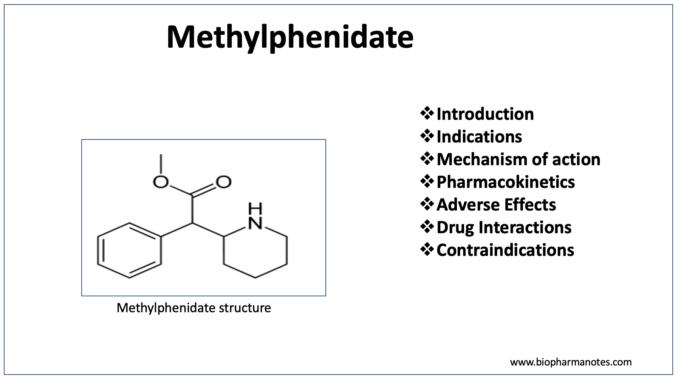
- Methylphenidate is central nervous system stimulant. It is federally controlled schedule II substance.
- Methylphenidate was first synthesized in 1944 and its initial use was analeptic for reversal of barbiturate induced coma. It’s use for managing ADHD begins in 1960s. It is also available as generic medicine.
Indications of methylphenidate
- Used as first line agent for treating ADHD (attention deficit hyperactivity disorder) in child and adults. The child should be older than 6 years to start methylphenidate therapy.
- Used as second line agent in treating narcolepsy in adults.
- Its off-label uses are treating fatigue in cancer patients, apathy in Alzheimer’s disease, refractory depression in geriatric patients. Also used to enhance cognitive performance or memory.
Mechanism of action of methylphenidate
- Its exact mechanism of action is not clear. However, it is supposed to act by inhibiting reuptake of dopamine and norepinephrine in brain. Hence, it results in increase of dopamine and norepinephrine in extracellular region in prefrontal cortex of brain.
- Though the pathophysiology of ADHD is not clear, certain research suggests that imbalance in dopaminergic and nor- adrenergic pathway in prefrontal regions of brain plays important role in its pathophysiology. Hence, methylphenidate is effective in ADHD patients.
- It is also thought to have role in mediation of alpha-1 adrenergic receptor activity. It is agonist of 5HT1A receptor which also helps to increase dopamine level in brain.
Pharmacokinetics of methylphenidate
- Methylphenidate is administered via oral route. After oral administration, it undergoes complete absorption. Various oral formulation like immediate release (IR), extended (XR) or sustained release (SR) are available. It is also available as transdermal patches. The patch is applied to hip for around 9 hours. It is advised to apply transdermal patch of methylphenidate in alternate hips each day.
- Two unique formulation are available- osmotic release delivery system and ER sphenoidal oral drug absorption system which have bimodal release.
- Its bioavailability increases when taken with food. Metabolism occurs in liver where it is deesterified by carboxylesterase CES1A1 to metabolite ritalinic acid. Ritalinic doesn’t have any or less pharmacological activity.
- Its protein-binding is low which may be the reason for its brief half-life. Most percentage of methylphenidate is excreted as metabolites in urine and small percentage is excreted via feces. Very small amount is excreted unchanged via urine.
Adverse effects
- In can affect CNS and cause insomnia and nervousness which are most commonly observed side effects of methylphenidate. Its other common side effects on CNS are dizziness, headache, restlessness.
- Some other common adverse effects include GI symptoms like nausea, vomiting, anorexia, abdominal pain and cardiovascular symptoms like tachycardia, palpitations and hypertension.
- It can also cause excessive sweating, agitation, mood swing, blurred vision or decreased libido. Transdermal patch may cause rashes and irritation at application site.
Drug Interactions
- It can interact with MAOI (Mono Amine Oxidase Inhibitors). So, methylphenidate is not used at least for 14 days after discontinuation of MAOIs.
- Co-administration with alcohol may potentiate CNS side effects of methylphenidate and increase chances of CNS side effects. Methylphenidate may decrease antihypertensive activity of drugs like hydralazine, labetalol on concurrent administration.
- It also has potential for abuse. IV or intranasal route is used when used for recreational purpose. It produces euphoric effect when taken through IV route. However, its abuse potential is less compared to that of cocaine.
Contraindications
- Contraindicated in patients hypersensitive to methylphenidate or other ingredients od its formulation.
- It is not used in children under 6 years of age.
- As it can cause risky effects in patients with cardiac abnormalities, it is mostly avoided in patients with structural cardiac abnormality, arrhythmia, or cardiomyopathy.
- It is not used in patients suffering from or with history of glaucoma, hypertension, and Tourette syndrome.
- It is not preferred to use in anxious or agitated patients.
References
- https://www.statpearls.com/ArticleLibrary/viewarticle/25085
- https://go.drugbank.com/drugs/DB00422
- Challman TD et al. Methylphenidine- Its Pharmacology and Uses. Mayo Clin Proc 2000; 75: 711-721
- Briars L et al. A Review of Pharmacological Management of Attention-Deficit/Hyperactivity Disorder. J Pediatr Pharmacol Ther.